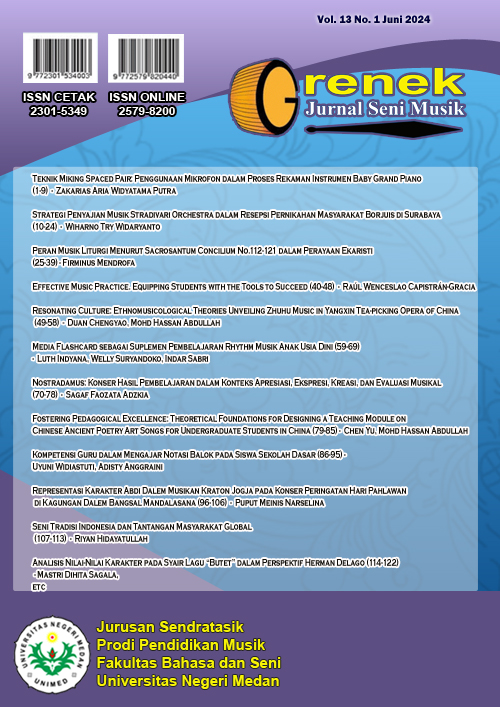Persepsi Multisensori dalam Proses Pembentukan Ekspresi Musikal Musisi
DOI:
https://doi.org/10.24114/grenek.v13i1.56620Keywords:
Persepsi Lintas Modal, Ekspresi Musikal Musisi, Temporalitas Emosi MusikalAbstract
Keputusan ekspresi musisi merupakan aspek vital yang menentukan keberhasilan musisi dalam komunikasi musikal antara komponis, pemain, dan pendengar. Dengan demikian selain keterampilan teknis untuk mengeksekusi notasi, musisi juga memerlukan wawasan mengenai aspek-aspek apa saja yang terlibat dalam membuat keputusan ekspresi yang sesuai. Penelitian ini bertujuan untuk mengelaborasi peran perspsi silang modal dalam proses pembentukan ekspresi musikal musisi. Pengambilan data dilakukan dengan wawancara semi tersetruktur terhadap 5 orang musisi berpengalaman meliputi 3 orang gitaris dan 2 orang cellist untuk mengungkap berbagai aspek selama proses pembentukan ekspresi musikal. Pengkodean deduktif dilakukan pada data transkrip, selanjutnya dihimpun ke dalam gugus-gugus tema yang diturunkan dari kerangka konseptual. Ditemukan tiga urutan proses yang terjadi selama pembentukan ekspresi pemain: pertama keputusan ekspresif musisi hampir selalu didorong oleh rekognisi emosi mereka terhadap struktur musik, di mana tensi emosi yang dirasakan akan secara dinamis berubah mengikuti kemiripan ikonikal struktur musik. Kedua, dimensi temporal yang melekat pada musik menyebabkan kategori emosi dasar seperti sedih, gembira, marah, takut, tidak memadai dalam mengakomodasi rekgonisi emosi yang ditangkap musisi dari notasi dan struktur musik. Ketiga, persepsi silang modal berperan sebagai cara menangkap keutuhan muatan emosi yang direkognisi musisi pada struktur musik. Berdasarkan hal itu keputusan ekspresi musikal (pengaturan parameter akustik) dibentuk berdasarkan kemiripan tensi emosi antara persepsi auditori dengan modalitas lainnya: dalam studi ini gerak benda (kinsetetik) dan pencahayaan (visual) menjadi referensi perseptual yang paling sering diacu narasumber.References
Clarke, E. F. (2005). Creativity in performance. Musicae Scientiae, 9(1), 157“182. https://doi.org/10.1177/102986490500900106
Crisinel, A. S., & Spence, C. (2012). A fruity note: Crossmodal associations between odors and musical notes. Chemical Senses, 37(2), 151“158. https://doi.org/10.1093/chemse/bjr085
Demos, A. P., Chaffin, R., & Logan, T. (2018). Musicians body sway embodies musical structure and expression: A recurrence-based approach. Musicae Scientiae, 22(2), 244“263. https://doi.org/10.1177/1029864916685928
Giordano, B. L., Egermann, H., & Bresin, R. (2014). The production and perception of emotionally expressive walking sounds: Similarities between musical performance and everyday motor activity. PLoS ONE, 9(12), 1“24. https://doi.org/10.1371/journal.pone.0115587
Guetta, R., & Loui, P. (2017). When music is salty: The crossmodal associations between sound and taste. PLoS ONE, 12(3), 1“14. https://doi.org/10.1371/journal.pone.0173366
Hanxi, L. (2023). Musical Expression in Music Performance and Its Enhancement Pathway. Frontiers in Art Research, 5(13), 87“92. https://doi.org/10.25236/far.2023.051316
Juslin, P dan Sloboda, J. (2001). Psychological Perspective on Music and Emotion. In J. Juslin, P dan Sloboda (Ed.), Music And Emotion: Theory and research (pp. 71“104). Oxford University Press. https://doi.org/https://doi.org/10.1093/oso/9780192631886.001.0001
Juslin, P. (2001). Communicating Emotion in Music Performance: A Review and Theoritical Framework. In J. Juslin, P dan Sloboda (Ed.), Music And Emotion: Theory and research (pp. 310“337). Oxford University Press. https://doi.org/https://doi.org/10.1093/oso/9780192631886.001.0001
Lindborg, P., & Friberg, A. K. (2015). Colour Association with Music Is Mediated by Emotion: Evidence from an Experiment Using a CIE Lab Interface and Interviews. PLoS ONE, 10(12), 1“26. https://doi.org/10.1371/journal.pone.0144013
Luck, Geoff & Toiviainen, P. (2006). Ensemble musicians™ synchronization with conductors™ gestures: An automated feature-extraction analysis. Music Perception, 24(2), 189“199. https://doi.org/https://doi.org/10.1525/mp.2006.24.2.189
MacRitchie, J., Buck, B., & Bailey, N. J. (2013). Inferring musical structure through bodily gestures. Musicae Scientiae, 17(1), 86“108. https://doi.org/10.1177/1029864912467632
Miles B.Matthew & Huberman, M. (1994). Qualitative Data Analysis: An Expanded Sourcebook (R. Holland (ed.); Second Edi). SAGE Publications, Inc.
Müller, V. I., Cieslik, E. C., Turetsky, B. I., & Eickhoff, S. B. (2012). Crossmodal interactions in audiovisual emotion processing. NeuroImage, 60(1), 553“561. https://doi.org/10.1016/j.neuroimage.2011.12.007
Oktadus, Y. H. (2019). Asosiasi pengalaman keseharian musisi dengan interpretasi musikal (studi kasus repertoar capricho arabe karya f. Tarrega). Institut Seni Indonesia Yogyakarta.
Peltola, H. R., & Saresma, T. (2014). Spatial and bodily metaphors in narrating the experience of listening to sad music. Musicae Scientiae, 18(3), 292“306. https://doi.org/10.1177/1029864914536199
Pitteri, M., Marchetti, M., Priftis, K., & Grassi, M. (2017). Naturally together: pitch-height and brightness as coupled factors for eliciting the SMARC effect in non-musicians. Psychological Research, 81(1), 243“254. https://doi.org/10.1007/s00426-015-0713-6
Simangunsong, E., Saragih, R. H., Purba, E. U., Sembiring, S. S., & Tambunan, A. (2023). Tinjauan Musikalitas: Penyajian Lagu Tondi-Tondiku Karya Herbert Aruan oleh Style Voice dan Sanga Pajumpang Band. Grenek Music Journal, 12(2), 218. https://doi.org/10.24114/grenek.v12i2.54074
Taipale, J. (2015). Empathy and the Melodic Unity of the Other. Human Studies, 38(4), 463“479. https://doi.org/10.1007/s10746-015-9365-1
Thompson, M. R., & Luck, G. (2012). Exploring relationships between pianists™ body movements, their expressive intentions, and structural elements of the music. Musicae Scientiae, 16(1), 19“40. https://doi.org/10.1177/1029864911423457
Van Zijl, A. G. W., & Luck, G. (2013). Moved through music: The effect of experienced emotions on performers™ movement characteristics. Psychology of Music, 41(2), 175“197. https://doi.org/10.1177/0305735612458334
Van Zijl, A. G. W., & Sloboda, J. (2011). Performers™ experienced emotions in the construction of expressive musical performance: An exploratory investigation. Psychology of Music, 39(2), 196“219. https://doi.org/10.1177/0305735610373563
Woolfe, Z. (2018). Yo-Yo Ma Wants Bach to Save the World. New York Times. https://www.nytimes.com/2018/09/28/arts/music/yo-yo-ma-bach-suites.html
Downloads
Published
Issue
Section
License
Copyright (c) 2024 Henry Yuda Oktadus

This work is licensed under a Creative Commons Attribution-ShareAlike 4.0 International License.
Authors published with the Grenek: Jurnal Seni Musik agree to the following terms:
- Authors retain copyright and grant the journal the right of first publication with the work simultaneously licensed under a Creative Commons Attribution License (CC BY-SA 4.0) that allows others to share the work with an acknowledgment of the work's authorship and initial publication in this journal.
- Authors are able to enter into separate, additional contractual arrangements for the non-exclusive distribution of the journal's published version of the work (e.g., post it to an institutional repository or publish it in a book), with an acknowledgment of its initial publication in this journal.
- Authors are permitted and encouraged to post their work online (e.g., in institutional repositories or on their website) prior to and during the submission process, as it can lead to productive exchanges, as well as earlier and greater citation of published work. (See The Effect of Open Access)








